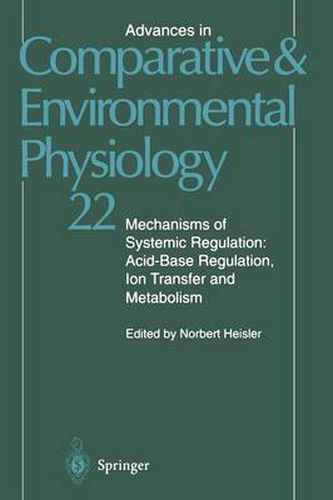Readings Newsletter
Become a Readings Member to make your shopping experience even easier.
Sign in or sign up for free!
You’re not far away from qualifying for FREE standard shipping within Australia
You’ve qualified for FREE standard shipping within Australia
The cart is loading…






This title is printed to order. This book may have been self-published. If so, we cannot guarantee the quality of the content. In the main most books will have gone through the editing process however some may not. We therefore suggest that you be aware of this before ordering this book. If in doubt check either the author or publisher’s details as we are unable to accept any returns unless they are faulty. Please contact us if you have any questions.
Various endogenous and environmental challenges of homoiostasis have resulted in the evolution of apparently quite different mechanisms for the same or similar functions in individual representatives of the animal kingdom. One of the prominent achievements of comparative physiology over the last few decades has been the description of regula- tory features common to many studied species beyond the extreme diversity of their morphological forms. Delineation offunctional princi- ples universally applicable to the physiology and biochemistry of living systems became often possible through technical advances in the devel- opment of numerous new techniques, in many cases modified and adopted from other fields of science, but also by approaching certain problems using multifactorial analysis. The advance in technology has facilitated studies of minute functional details of mechanisms, which finally lead to better understanding of generally similar functions, covered by the multiple developments of Nature as a response to an extreme variety of different conditions. Improved understanding of specific mechanisms, however, has presented new problems at the level of system integration. The importance of the integrative aspect became particularly apparent during an international symposium on ‘Mecha- nisms of Systemic Regulation in Lower Vertebrates: Respiration, Circu- lation, Ion Transfer and Metabolism’ (organized in 1990 by Norbert Heisler and Johannes Piiper at the Max-Planck-Institut fUr experimen- telle Medizin at Gottingen/Germany).
$9.00 standard shipping within Australia
FREE standard shipping within Australia for orders over $100.00
Express & International shipping calculated at checkout
This title is printed to order. This book may have been self-published. If so, we cannot guarantee the quality of the content. In the main most books will have gone through the editing process however some may not. We therefore suggest that you be aware of this before ordering this book. If in doubt check either the author or publisher’s details as we are unable to accept any returns unless they are faulty. Please contact us if you have any questions.
Various endogenous and environmental challenges of homoiostasis have resulted in the evolution of apparently quite different mechanisms for the same or similar functions in individual representatives of the animal kingdom. One of the prominent achievements of comparative physiology over the last few decades has been the description of regula- tory features common to many studied species beyond the extreme diversity of their morphological forms. Delineation offunctional princi- ples universally applicable to the physiology and biochemistry of living systems became often possible through technical advances in the devel- opment of numerous new techniques, in many cases modified and adopted from other fields of science, but also by approaching certain problems using multifactorial analysis. The advance in technology has facilitated studies of minute functional details of mechanisms, which finally lead to better understanding of generally similar functions, covered by the multiple developments of Nature as a response to an extreme variety of different conditions. Improved understanding of specific mechanisms, however, has presented new problems at the level of system integration. The importance of the integrative aspect became particularly apparent during an international symposium on ‘Mecha- nisms of Systemic Regulation in Lower Vertebrates: Respiration, Circu- lation, Ion Transfer and Metabolism’ (organized in 1990 by Norbert Heisler and Johannes Piiper at the Max-Planck-Institut fUr experimen- telle Medizin at Gottingen/Germany).